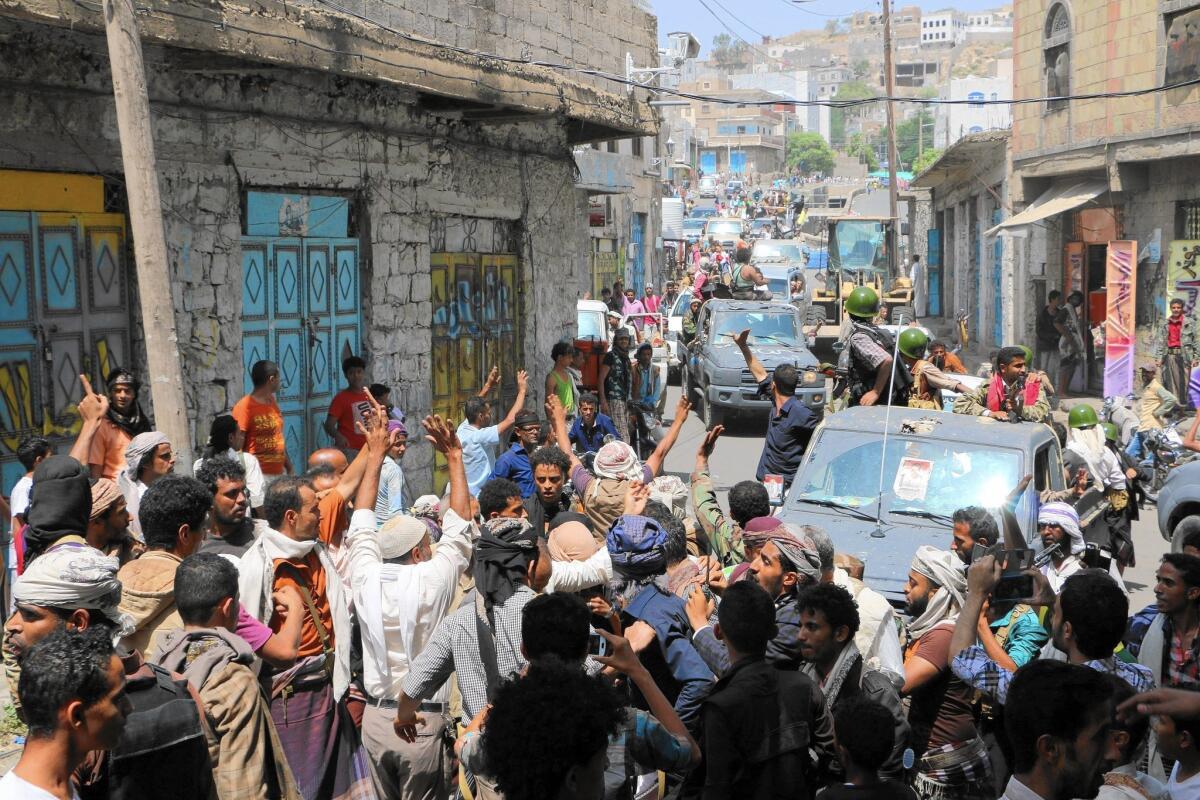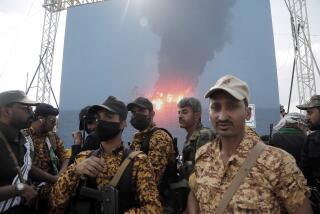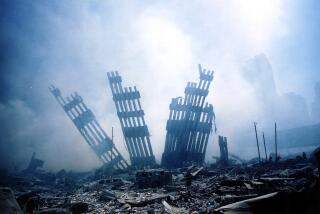U.S. boosts support role in Saudi-led airstrikes on Yemen

Fighters celebrate in Taizz after a battle with Houthi rebels in Yemen.
Reporting from SANA, Yemen â A Saudi-led military offensive against Houthi rebels in Yemen has scored major gains this month, including recapturing the strategic port of Aden and the countryâs largest air base, after the Pentagon more than doubled the number of American advisors to provide enhanced intelligence for airstrikes.
The role of about 45 U.S. advisors, up from 20, at joint military operations centers in Saudi Arabia and Bahrain has been vastly overshadowed by the far larger U.S.-led air war against Islamic State militants in Iraq and Syria. So has Yemenâs toll of civilian casualties and refugees.
The turmoil has benefited Al Qaedaâs powerful local franchise, which remains resilient and continues to seize territory. Fighters loyal to the extremist group captured three towns in southern Yemen this month, adding to their control of Mukalla, a provincial capital and port where they patrol in looted military vehicles and run roadside checkpoints.
NEWSLETTER: Get the dayâs top headlines from Times Editor Davan Maharaj >>
But on Wednesday, five men identified by Yemeni officials as Al Qaeda fighters were killed in a presumed U.S. drone strike in eastern Yemen, indicating a continued U.S. focus on the group.
In a multi-sided civil war, the Saudi-led coalition struggled for months to retake ground from the Houthis, a Shiite Muslim group. The rebels had forced the U.S.-backed president into exile in the spring and quickly swept across the Arab worldâs poorest nation.
The tide appeared to shift after Saudi Arabia and the United Arab Emirates landed about 3,000 troops and armored vehicles in Aden, Yemenâs second-largest city and most important port, on Aug. 2, the first major use of coalition ground forces in the war.
Together with pro-government tribal fighters, they pushed the Houthis out and established a crucial beachhead. Reportedly equipped with French tanks, Russian fighting vehicles and American mine-resistant troop carriers, they pressed 40 miles north and evicted the Houthis from the air base at Al Anad.
Until it was pulled out in March as the Houthis advanced, a U.S. special operations team was deployed at Al Anad to gather intelligence and launch drone strikes against Al Qaeda in the Arabian Peninsula, which the Obama administration considers the terrorist networkâs most dangerous branch because of its repeated attempts to attack American targets.
U.S. officials said last week they will not send the counter-terrorism team back to Yemen until the ousted president, Abdu Rabu Mansour Hadi, is restored to power in Sana.
Pro-government forces now have regained control of five southern provinces, the latest of them recaptured Saturday, and on Sunday pushed into Taizz, a key crossroads city about 160 miles south of Sana, the rebel-held capital. But Houthis remain firmly entrenched in Sana and in traditional strongholds farther north.
The Obama administration is providing intelligence, munitions and midair refueling to coalition aircraft, and U.S. warships have helped enforce a blockade in the Gulf of Aden and southern Arabian Sea intended to prevent weapons shipments from Iran to the Houthis. The coalition includes five Persian Gulf Arab states plus Jordan, Egypt, Morocco and Sudan.
Human rights groups say the sea cordon also cuts Yemen off from imports of basic commodities, including food and fuel, adding to the nationâs miseries. Overall, fighting since March has killed nearly 4,300 people, nearly half of them civilians, and forced more than 1.3 million others to flee their homes, according to United Nations agencies.
Humanitarian groups warn that even with aid beginning to arrive at the port in Aden, medical supplies and fuel remain in short supply. Destruction of key infrastructure has left millions without access to clean water or electricity, and a quarter of the countryâs health facilities are shuttered, according to the World Health Organization. Outbreaks of dengue fever, malaria and other treatable ailments have become deadly.
âThe humanitarian situation is nothing short of catastrophic,â Peter Maurer, president of the International Committee of the Red Cross, said after a recent three-day visit to the battered country. âAnd it is getting worse by the day.â
The White House has made it clear it will provide strong support for the Saudis and their Sunni Arab coalition. The U.S. and its allies regard the Houthis as proxies of Iran and accuse Tehran of providing them with weapons, which Iran and the Houthis deny.
At the same time, the White House is relying on Saudi Arabia and the gulf states to support President Obamaâs landmark nuclear agreement with Iran. Despite public misgivings, none has expressed opposition to the deal.
Human rights groups say airstrikes that were based on faulty intelligence, or that simply went astray, have killed hundreds of civilians since Saudi warplanes began bombing March 26. Human Rights Watch recently released a shaky video of airstrikes on July 24 hitting apartment buildings that it said housed power plant workers.
At least 65 people, including 10 children, were killed in the attack, said Belkis Wille, a Human Rights Watch investigator who visited the scene less than 48 hours after the strike.
âThere was no question this was a coalition airstrike,â she said in an telephone interview. âThat hasnât been disputed.â
Pentagon officials say 45 U.S. military and intelligence personnel help the coalition evaluate potential bombing targets and calculate blast areas of missiles and bombs in an effort to prevent civilian casualties. U.S. spy satellites and reconnaissance drones relay live video before and after the bombs hit.
NEWSLETTER: Get essential California headlines delivered daily >>
But Pentagon officials stressed the team is not responsible for individual operations.
âWe are confident that the intelligence and advice we pass on to Saudi Arabia and other coalition members is sound, giving them the best options for military success consistent with international norms and mitigating the potential for civilian casualties,â said Cmdr. Kevin Stephens, a U.S. military spokesman in Bahrain. âThe final decisions on the conduct of operations in the campaign are made by the members of the Saudi-led coalition, not the United States.â
The coalition maintains that it primarily uses satellite- and laser-guided munitions, but Human Rights Watch says unguided bombs and U.S.-supplied cluster munitions have been dropped in densely populated urban areas.
Witnesses and officials have reported devastation of neighborhoods near rebel-held ammunition dumps, with some airstrikes setting off secondary explosions that wreck homes and shops. Some civilians have come under fire because they live close to prominent Houthi loyalists.
Ahmed Qamri, a father of two young boys, said he believes five airstrikes targeted his neighborhood in Sana last month because it is home to a former military commander who is the nephew of deposed Yemeni strongman Ali Abdullah Saleh, who has allied himself with the Houthis.
âThe first explosion woke us,â Qamri said. âNothing in my house remained in its place; all my windows broke. My 4-year-old was screaming, âDad, what should I do?ââ
The family survived by taking shelter in an inner room, he said.
Twitter: @wjhenn
Twitter: @laurakingLAT
Times staff writers Hennigan and King reported from Washington and Cairo, respectively. Special correspondent Al-Alayaa reported from Sana.
ALSO:
Air attack hits crowded market in Syria; more than 80 dead, watchdog says
Senate Republican comes out against Iran deal
Palestinian hunger striker loses consciousness at Israeli hospital
More to Read
Sign up for Essential California
The most important California stories and recommendations in your inbox every morning.
You may occasionally receive promotional content from the Los Angeles Times.











